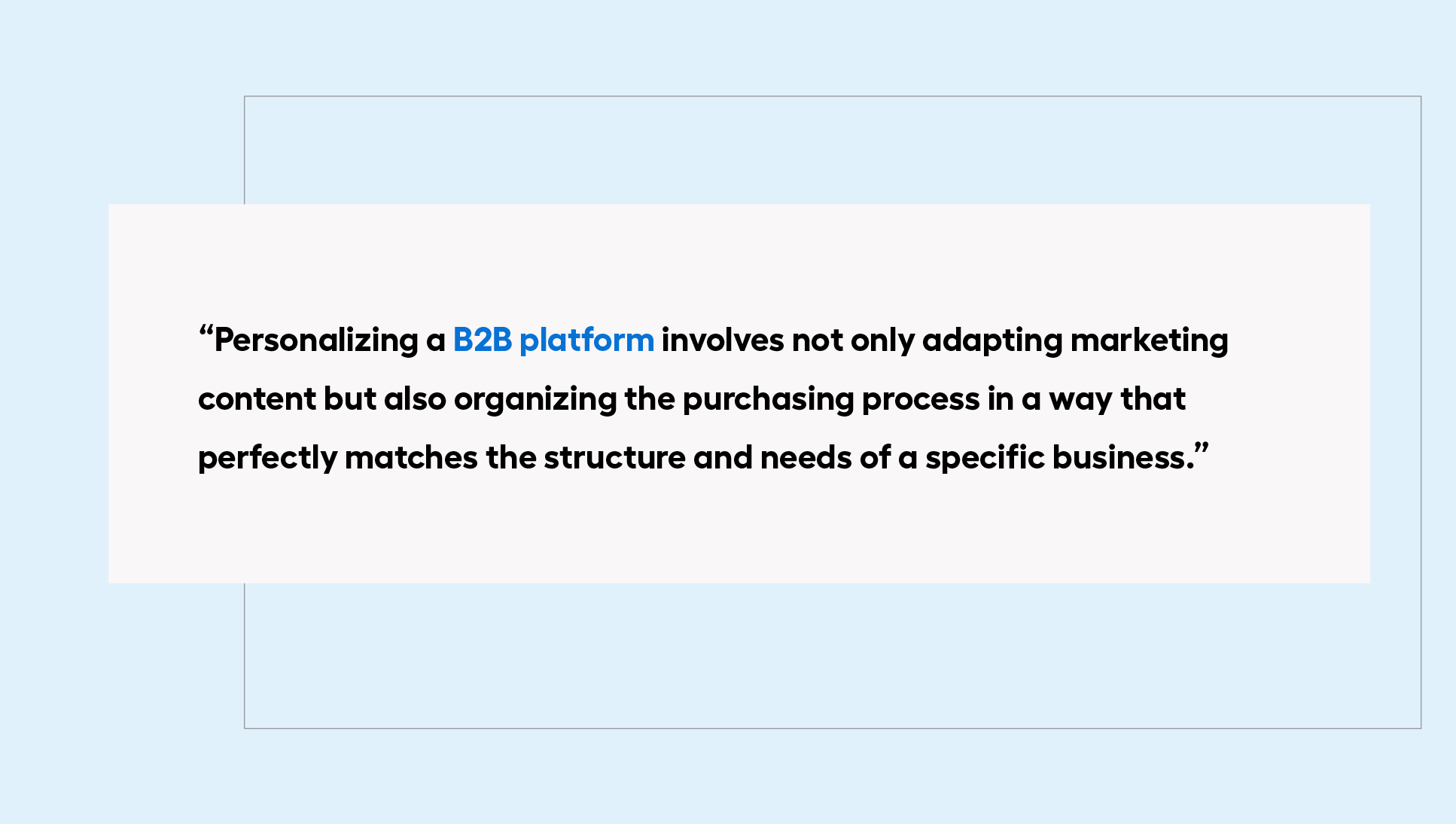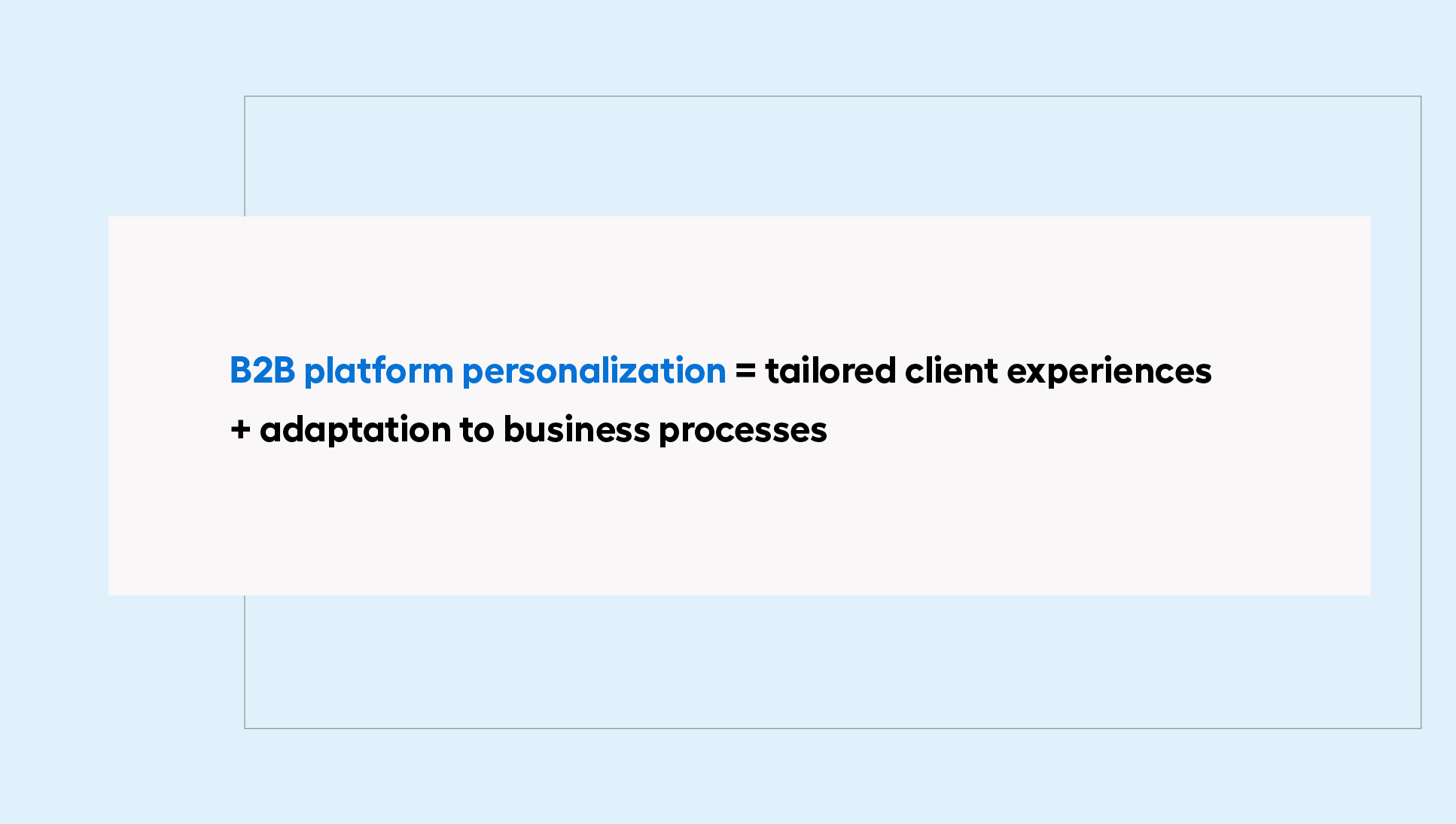Personalization of the B2B platform - how to meet expectations of modern contractors?
Table of contents
- B2B Personalization – what sets it apart?
- Beyond customer satisfaction - the full benefits of B2B platform personalization
- Where does personalization fit on a B2B platform? Industry examples
- More than just User Experience - what else requires personalization in B2B?
- Put client experiences first
The modern business landscape is increasingly shaped by Millennials (Generation Y) and Generation Z. According to Forrester Research, these groups already account for around 64% of decision-makers in the B2B sector, bringing their digital habits and expectations from personal life into professional settings. How should you, as a B2B platform owner, respond to this trend?
The answer is simple: personalization. For today’s buyers, it’s not just about product quality but also the simplicity, intuitiveness, and flexibility of the purchasing process. They expect tailored offers that meet their specific needs, dynamic recommendations, and user-friendly tools that save time. In this context, personalization is no longer optional—it’s a necessity that can determine the success or failure of your platform.
In this article, we explore how to effectively implement personalization on B2B platforms, the specific benefits it can deliver and examples of functionalities that companies in the industry are already leveraging.
B2B Personalization – what sets it apart?
The essence of personalization in eCommerce boils down to one goal - crafting a shopping experience so tailored to the customer that it not only drives them to place an order but also fosters lasting, loyalty-based relationships. This principle holds true for both B2B and B2C, but the way it is implemented in the B2B sector is fundamentally different. It requires a deeper understanding of business-specific needs, advanced tools, and a highly individualized approach.
So, what makes B2B personalization stand out compared to B2C?
First and foremost, the nature of relationships. In B2C, interactions often follow a standardized flow where the customer adapts to the offered products and procedures. In contrast, B2B relies heavily on tailored agreements, which can vary significantly between clients. These diverse needs must be reflected in personalization efforts.
Good B2B personalization ensures that every client enjoys a unique purchasing experience - one that accommodates not just their product preferences but also customized contract terms, tailored pricing, exclusive discounts, and personalized payment methods. Personalizing a B2B platform is thus a much more complex process. It involves not only adapting marketing content but also reorganizing the purchasing process itself to align perfectly with the structure and requirements of each individual company.

Beyond customer satisfaction - the full benefits of B2B platform personalization
Creating personalized experiences demonstrates that you understand your clients' needs and can cater to them effectively. While this is a major advantage, it’s not the only one. What else can your B2B business gain from implementing effective personalization?
- Optimized sales processes - B2B personalization benefits not only your clients but also your internal operations. Customized experiences simplify the purchasing process, shorten decision-making times, and minimize uncertainties along the buyer's journey. This leads to more efficient sales operations and customer support that is better aligned with the real needs of your clients.
- Standing out in the market - The B2B industry is still undergoing digital transformation. According to the VML report “The B2B Future Shopper Report 2023-24”, only 49% of businesses in this sector were operating online as of 2023. However, 68% of buyers say they plan to use online purchasing channels more frequently in the future. In this rapidly evolving environment, a personalized platform allows you to stand out from the competition and gain an edge in attracting increasingly demanding business partners.
- Better use of business data - effective personalization relies on robust data management, creating opportunities for broader applications. Analyzing client behavior helps you not only tailor your offerings but also identify purchasing trends and predict future needs. This knowledge translates into tangible business advantages.
Where does personalization fit on a B2B platform? Industry examples
Personalization on B2B platforms can take many forms, tailored to the specific needs and expectations of business clients. The key is to leverage the platform’s features in a way that makes every user feel the offerings are customized to their exact requirements. Below are some concrete examples of areas where personalization can significantly enhance the B2B purchasing experience.
Customized pricing
Individual pricing policies are a cornerstone of B2B relationships. Clients often negotiate tailored rates over weeks or months to secure terms that work for them and allow them to offer competitive pricing to their own customers. It’s crucial to accurately reflect these agreements on your sales platform.
Through account-specific personalization, unique prices can be assigned to individual products, along with customized discounts or tiered pricing thresholds. For instance, a discount could be automatically activated once a specific order value is reached. This approach not only increases client satisfaction but also streamlines the purchasing process and reinforces their loyalty to your company.
Personalized payment options
Trade credit limits are a popular payment model in B2B, allowing deferred payments and providing clients with greater financial flexibility. The credit limit amount and payment terms are often negotiated individually, making them an excellent area for personalization.
On a sales platform, trade credit limits can be displayed transparently and interactively, such as with a dynamic bar that visually shows how much of the limit has been used. This feature helps clients manage their obligations more effectively. Additionally, the system can automatically send reminders about upcoming payment deadlines or notify users when their credit utilization reaches a certain threshold.
Product recommendations
Personalized product recommendations, a staple in B2C eCommerce, also work well on B2B platforms. By analyzing purchase history, the system can suggest products that complement the client’s orders or meet their seasonal needs. This approach boosts the value of the shopping cart and saves time for clients, who may spend hours placing large bulk orders.
Dedicated account manager
When issues arise with order management, clients often need quick access to the person responsible for their account.Assigning a dedicated account manager, with easily accessible contact details (e.g., in the cart or client account view), increases trust and a sense of security for the client.
Flexible delivery options
Business orders are often larger and more logistically complex than those in B2C. Providing clients with options to select specific delivery dates, transport methods, or split orders into smaller batches is critical.
Multi-cart functionality
Multi-cart functionality is invaluable for businesses placing complex orders that span different departments, subsidiaries, or projects. This feature allows clients to manage multiple carts simultaneously, assigning them to specific budgets, billing periods, or categories, streamlining their workflow. The ability to save and edit carts over time enables flexible planning, especially for large bulk orders or purchases requiring multi-level approvals within a company.
Multi-cart functionality also allows for tailoring fulfillment terms for each cart, such as delivery schedules, pickup locations, or payment methods.
More than just User Experience - what else requires personalization in B2B?
Personalization in the business-to-business sector goes beyond tailoring individual user experiences.In many cases, it’s also essential to adapt the sales platform to the unique business processes and organizational structure of the client. This includes accounting for employee hierarchies, decision-making processes, and requirements for managing access and permissions. How does this look in practice?
For example, a client may assign specific employees permissions to place orders, approve purchases, or manage budgets. This functionality is particularly valuable for larger companies where purchasing processes require approval at various levels of the hierarchy.

Put client experiences first
Building long-term relationships, understanding clients, and adopting a personalized approach are key elements of success in the B2B space. Today, the digitization of business relationships opens up new opportunities in this area, with platform personalization being one of the most effective tools. So how can you do it right?
The first critical step is a pre-implementation analysis, which helps you understand your company’s specific needs and plan functionalities that align perfectly with its structure and processes. From there, it’s worth investing in flexible solutions like Magento, which offer scalability and easy future modifications. Entrusting the process to an experienced software house ensures a smooth implementation.
If you want your B2B platform to become a tool that delivers real competitive advantages, contact us. Together, we’ll create a personalized solution that not only meets your clients’ expectations but also drives tangible growth for your business.



